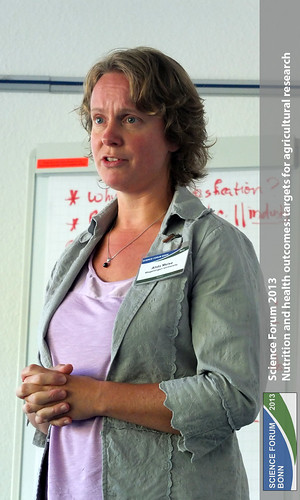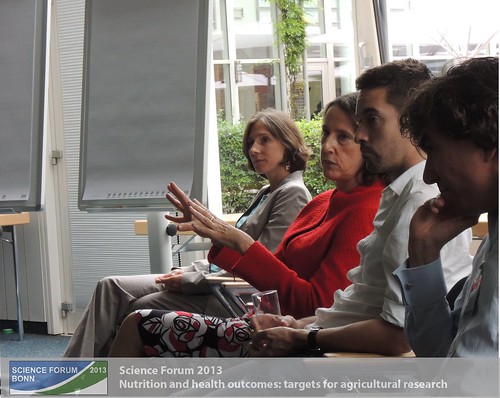Science Forum 2013
Research agenda should start from the plate
Mon, 09/30/2013 - 16:48 — Minette Flora M...
“Look at what people consume”, dares Frank Rijsberman of the CGIAR Consortium of Board Members. “Research agendas in the past had a strong focus on the supply side, it is high time to re-shift and start with the demand – basically looking at what people want”, he added. Earlier, there was an over-focus on staple based food such as grains. However, there should be an appropriate balance of food into CGIAR programs such as animal sourced food, legumes and lentils
 Plenary: The Way Forward
Toilets in the research agenda
Frank Rijsberman apparently is a water person having worked in IWMI and the Bill & Melinda Gates Foundation’s project on Water, Sanitation & Hygiene. With these backgrounds, he stressed on the importance of water as an input to agriculture and emphasized to bring sanitation and hygiene in the agenda. He gave an example on the impact of treated water (from toilets) in peri-urban agriculture.
Plenary: The Way Forward
Toilets in the research agenda
Frank Rijsberman apparently is a water person having worked in IWMI and the Bill & Melinda Gates Foundation’s project on Water, Sanitation & Hygiene. With these backgrounds, he stressed on the importance of water as an input to agriculture and emphasized to bring sanitation and hygiene in the agenda. He gave an example on the impact of treated water (from toilets) in peri-urban agriculture.
 Plenary: The Way Forward
Toilets in the research agenda
Frank Rijsberman apparently is a water person having worked in IWMI and the Bill & Melinda Gates Foundation’s project on Water, Sanitation & Hygiene. With these backgrounds, he stressed on the importance of water as an input to agriculture and emphasized to bring sanitation and hygiene in the agenda. He gave an example on the impact of treated water (from toilets) in peri-urban agriculture.
Plenary: The Way Forward
Toilets in the research agenda
Frank Rijsberman apparently is a water person having worked in IWMI and the Bill & Melinda Gates Foundation’s project on Water, Sanitation & Hygiene. With these backgrounds, he stressed on the importance of water as an input to agriculture and emphasized to bring sanitation and hygiene in the agenda. He gave an example on the impact of treated water (from toilets) in peri-urban agriculture. If Vitamin A Capsule Supplementation is cheap, then why do we need bio-fortified food?
Mon, 09/30/2013 - 14:50 — Minette Flora M...
“Biofortification is more cost effective because a seed can be passed on to your neighbors”, says Howarth Bouis of Harvest Plus. He tries to compare the cost categories of Vitamin A capsule supplementation program vis a vis breeding crops to increase their nutritional value, also called biofortification. The former which cost about USD0.2–0.3 / per capsule is relatively cheap; however, the intervention has to be implemented each year to Vitamin A deficient target groups. “Whereas the latter is more sustainable, because you pass on to the community the breeding of bio-fortified seeds”. With the power of agricultural research, germ plasms of Vitamin A rich food sources such as cassava, maize and orange sweet potato has been developed and released for adoption.
 Howarth Bouis
Howarth Bouis
 Howarth Bouis
Howarth Bouis
Would you like to be fed with half a kilo of cassava per day?
Sun, 09/29/2013 - 18:15 — Rahel Wyss
Study as a proof of principles
“Why did you go to Kenya with cassava?” asked a Ghanian early career scientist from the audience during discussion, regarding a study about introduction of high β-carotene containing yellow cassava in Kenya. In fact, the Vitamin A deficiency of the population in Ghana would be much higher than in Kenya, he adds. The presenter from Wageningen University in Holland, Alida Melses responses: “The study is a proof of principle – it doesn’t matter where you work as long as you demonstrate that it works. The area was chosen by practical reasons.”
 Alida Melse-Boonstra, Wageningen University, Netherlands, about improving nutrition through staple foods in Africa
Alida Melse-Boonstra, Wageningen University, Netherlands, about improving nutrition through staple foods in Africa
 Alida Melse-Boonstra, Wageningen University, Netherlands, about improving nutrition through staple foods in Africa
Alida Melse-Boonstra, Wageningen University, Netherlands, about improving nutrition through staple foods in Africa
Smaller and bigger – why does it matter?
Fri, 09/27/2013 - 23:34 — Louisa Wong
If a smallholder farmers in Central Africa earns an extra dollar, what kind of food would the farmer buy? The answer is - starchy staple food, fruits, meat and vegetables. If compared to a guy from a richer country like the United States, this guy would rather spend his extra dime on beverages and tobacco or dine out in a junky fast food chain to enjoy a cheeseburger with a diet coke. “The Afrint Project” is a study by from Lund University; Agnes D. was explaining in the Breakout session that her project team tries to find out the challenges faced by staple crop intensification in relation to farm sizes and urbanisation.
How soon do you want to die? It´s up to you!
Thu, 09/26/2013 - 09:46 — Viviane Meyer
In the session about NCDs (non-communicable diseases), diet-based problems were illustrated and discussed and the link to agricultural practices was analysed. Evidence was gathered and possibilities for future agricultural research were presented under the guidance of Mr. K. Srinath Reddy. Some outcomes of this session were that people get severe illnesses such as cancer and diabetes due to the food each person eats- so you are what you eat- namely fat and ill or slim and healthy.
Bridging the gender gap
Thu, 09/26/2013 - 01:36 — Louisa Wong
According to the World Economic Forum (WEF) report, Lesotho is ranked first in Africa for bridging the gender gap and eighth in the entire world - with 95% of women able to read and write, compared with 83% of men. Women can take up important positions in the job market and can be as competitive as men. It’s only one side of the story.
 Lynn Brown was sharing her point of view about gender sensitive agriculture in the Breakout session about under-nutrition
Lynn Brown was sharing her point of view about gender sensitive agriculture in the Breakout session about under-nutrition
 Lynn Brown was sharing her point of view about gender sensitive agriculture in the Breakout session about under-nutrition
Lynn Brown was sharing her point of view about gender sensitive agriculture in the Breakout session about under-nutrition
Let’s keep it informal!
Wed, 09/25/2013 - 17:35 — Kirstin Ohlendorf
In the breakout session on “Leveraging Value Chains for better nutrition and food safety: Lessons for CGIAR Research”, Delia Grace from ILRI in Nairobi Kenya highlighted the importance of the informal sector. Research indicates that in many low income countries, e.g. milk is marketed via informal markets and this trend to supermarkets is not valid for all countries – also not with regards to consumer preferences.
Furthermore the informal sector is highly relevant for women who can sell their products in an informal way, but at the same time highly risky in terms of food safety.
Is the formal sector better?
What the Scientific world itself eats
Wed, 09/25/2013 - 17:27 — Eva Hilt
Within the unconventional setting of wild animals of the African Savannah and images of the foods of people all around the globe, the researchers and participants of the Science Forum were enjoying the conference dinner on Monday evening.




